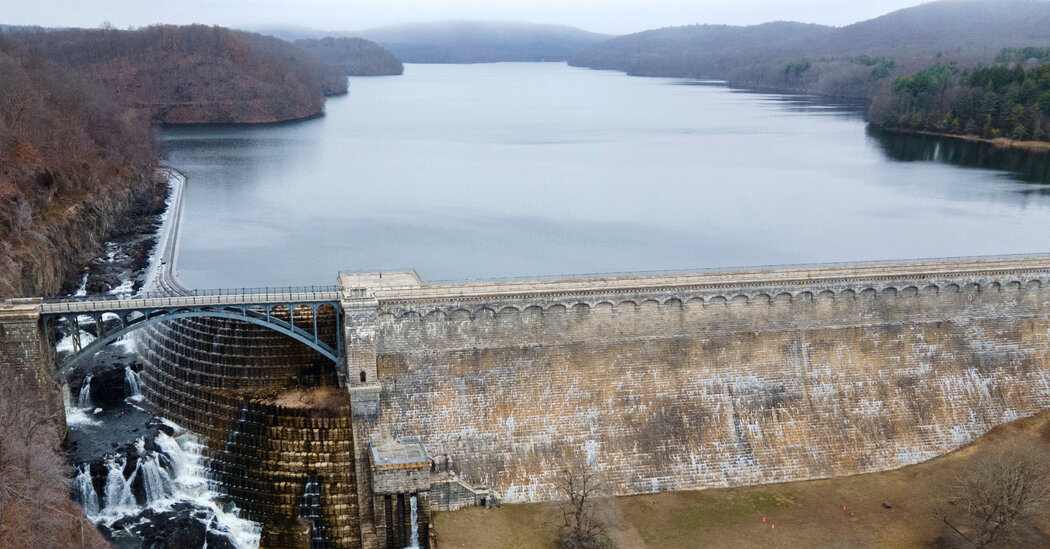Salt Threatens New York City’s Water Safety
A new environmental report finds that rising salt levels in New York City’s water supply could make some of it undrinkable by the turn of the century. Road salt is leaching into the reservoirs that hold New York City’s tap water and could make some of it unhealthy to drink by the turn of the century, according to a new study commissioned by city environmental officials. The study, released last week by the city’s Department of Environmental Protection, found that while salt was edging upward throughout New York’s vast watershed, it was especially pronounced in the New Croton Reservoir, just north of the city. In that supply, which provides about 10 percent of the city’s drinking water, levels of chloride — a chemical found in salt and an indicator of salinity — tripled over the last 30 years. If the trend continues, drinking water from the New Croton Reservoir may not meet current safety standards by 2108, according to the report.
Rising Salt Levels Threaten New York City’s Water Supply
Efforts to address the rising salinity in New York City’s water supply involve a multifaceted approach that extends beyond adjustments in road salt usage. Government agencies are also considering the implementation of new technologies and alternative materials to mitigate the adverse effects of salinity on both water quality and infrastructure. Strategies such as utilizing thermal devices for precise salt application and exploring the use of beet juice mixed with brine offer promising ways to reduce the overall amount of salt required for winter road maintenance. Furthermore, the potential introduction of a task force could lead to more collaborative efforts between city and state officials, aimed at finding innovative solutions to preserve the quality of the water supply. This initiative reflects a broader commitment to safeguarding environmental resources, ensuring public health, and maintaining the integrity of crucial infrastructure amid evolving challenges associated with climate change.
Impact of Salinity on Ecosystems and Human Health
Road salt, widely used for deicing, poses significant environmental challenges despite its role in maintaining road safety. The blend of knowledge and innovation could pave the way for solutions, such as utilizing alternative materials like beet juice and sand to reduce reliance on salt. Legislative efforts, like those spearheaded by State Senator Pete Harckham, aim to bring together city and state resources to address the growing salinity issue. This initiative highlights the balance needed between maintaining safe infrastructure and ensuring environmental health, a challenge that becomes more pressing as salt levels continue to rise in key water supplies like the New Croton Reservoir. With the ecological and human health stakes being high, re-evaluating current practices becomes not only beneficial but necessary to safeguard New York’s water resources for future generations.
Alternatives to Traditional Road Salt
New York City officials also plan to engage local communities and raise awareness about the impact of rising salinity in the water supply. This initiative includes educational campaigns to inform the public about the sources and consequences of increased salt levels, aiming to foster a collaborative effort in addressing the issue. In addition to technological advancements and regulatory changes, community involvement is seen as a vital component of a comprehensive strategy to protect the water resources. “Empowering residents with knowledge about the impacts of road salt and the importance of reducing its use can lead to more environmentally friendly practices,” Mr. Aggarwala noted. Through these efforts, the city aims to ensure that its renowned tap water remains safe and reliable for future generations, despite the challenges posed by urban development and climate change.
Maintaining a Balance Between Environmental Protection and Public Safety
The threat of rising salinity levels in New York City’s water supply underscores the urgent need for concerted efforts in managing road salt usage and exploring alternative measures. With significant health and environmental implications at stake, officials and legislators must act swiftly to safeguard both the current and future quality of this vital resource. Balancing environmental concerns with practical road safety measures will be essential in ensuring that New York City continues to enjoy a resilient and reliable water supply. As the city navigates these challenges, the collaboration between local governments, state authorities, and communities will be crucial in devising and implementing sustainable solutions.















Post Comment